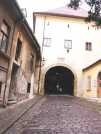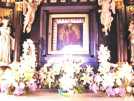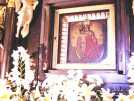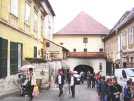
Croatia facts and history in brief
Do you know the story about Our lady of the Stone Gate in Zagreb?
Written by Marko Vrdoljak
Gates of stone.
The main entry into today's Upper City, a
mysterious passage into history and legend,
gates that lead through time into the
timeless peace of old Zagreb.
Step through the «Porta lapidea», the only
preserved city gates of the medieval settlement
Gradec, today's Upper City and you might
catch a glimpse of the past.
These for Zagreb important gates, were
created and preserved by chance and by
unusual circumstance connected
to the history of Croats.
Namely, by the directive of the Hungarian
King Bela IV, and for protection from Mongol
attacks in the year 1241 high fortifications
were built with towers around today's Upper
City into which controlled entry was possible
then only through the small gates Dverce from
the south-west side or through the Stone Gate
from the eastern side of the
newly erected ramparts.
The gates are, after a long period, expanded
and renewed during the times of the greatest
Turkish threat in the 16th century along with
works on the repair and maintenance
of the fortifications.
During this period a bridge is erected over
the defensive moat just before the
fortifications for whose roof work the
city authorities purchase oak.
The rooms in the building that line the city
gates in this time serve as storage areas,
and it is there that the first stores
are opened in the 17th century.
One of them is today a candle store.
The history and hostile forces of the wars
of those days caused many fires which in 1645,
1674, 1706 and 1731 ravaged Gradec, and in
which the Stone Gate suffered several times.
In connection with the last
fire a legend developed.
Namely, in an apartment on the first floor of
the building above the Stone Gate Mrs. Modlar
and her neighbours, just following the fire,
in ashes on the floor found a depiction of
the Virgin Mother Mary with the child Jesus
portrayed as the Queen of Angels. (The author
and dating of this painting is to this day
unknown, although it is considered to be the
valuable work of a local master
from the 16th or 17th century).
Even though the frame of the painting was burned
during the fire the painting remained entirely
undamaged which was almost unbelievable
considering that all the wooden parts of the
building had been entirely destroyed by fire.
This was a miracle, concluded the finders,
and from that day the painting was
attributed with miraculous powers.
The widow Modlar raised an altar under the
vault of the Stone Gate with the miraculous
painting over which an inscription was placed:
«Aid in all distress and against fires».
The altar was opened to the public, and the
painting could even be touched until 1778 when
the city government erected an artistically
forged iron fence by the locksmith Ivan Juraj
Chorth, which is today considered the most
beautiful and largest example of baroque
smithery in northern Croatia.
In the great baroque renewal of 1760 the
Stone Gate is further expanded, the vault
is again painted and the building
is roofed with clay tiles.
The rooms above the Stone Gate are converted
by the city authorities to residences and rented.
In 1776 these rooms are refurnished as classrooms
for an elementary school and then in the second
half of the 19th century they are
granted to a girls school.
In a public bidding, which was then a usual
method of commerce, the apartment above the
Gate is rented to Mrs. Barbara Lenar, and only
some twenty days later the city decides to tear
down the Stone Gate. One of the city's
merchants, Mr. Daniel Jaksic, suggests then
that he bear all the expenses of the demolition
and rebuilding and draws up new plans for the
Stone Gate as a combination of a traffic route,
a commercial building and a small chapel.
For unknown reasons the signing of a contract
and approval of the new plans, between Mr. Jaksic
and the City, did not go through.
The Stone Gate was then preserved from all intervention.
In the budget of the City of Zagreb for the year
1878 the idea of the Stone Gate's demolition
resurfaced but was again not put into action
as many citizens reacted to it with disapproval.
But, as every age has its crazy coachmen and
drivers, so it was in distant 1880 that an
impatient coachman overturned his coach right
in the Stone Gate provoking a meeting of the
city representatives which, prompted by this
unseeming event for the otherwise peaceful
Zagreb, decide to demolish the Stone Gate and
build a safer road in its place.
By a twist of fate the Stone Gate was again
spared because at the time when construction
was to have begun the city treasury, from which
the works were to have been funded, was empty.
So that the city government could in some way
show its authority it barred passage to all
coachmen and installed transverse bars.
Not long afterwards, in 1907, the City authorities
again debated the demolition of the building
and Stone Gate with the argument that the Gate
served no purpose, as they had been only a
passage for the past two centuries.
The society «Braca hrvatskog zmaja»
("Brothers of the Croatian Dragon") then
assumed possession of the old building and
gate from the city administration and established
three today significant cultural-educational
and scientific institutions:
The City Library, the Historical Archive of
Zagreb and the Museum of the City of Zagreb.
The "Painting of the Blessed Virgin Mary
under the Stone Gate" is there today and
he tiles with inscriptions of gratitude
attached to the wall about it are a witness
to the power of human will, trust and faith.
On the occasion of the 200th anniversary of
the miraculous preservation of the painting in 1931,
St. Mary and Christ on the painting receive,
as an expression of gratitude from the city,
a golden crown with gems that now make up an
integral part of the painting.
In 1991 the Archbishop of Zagreb proclaimed
the Mother of God of the Stone Gate to be a
special protector of Zagreb
and the whole of Croatia.
Therefore, whether you are a citizen of Zagreb
or not, take a stroll to the Stone Gate and
feel the peace and tranquillity of lighted
candles in the semi-darkness, make a wish
and continue your journey knowing
that someone is protecting you.

Hui Chin and I visited Croatia during our European
travels in 2005.
We have enjoyed our stay in the country, but were very
disappointed with the train services.
Before our departure from new Zealand, we purchased
a rather expensive Regional Eurail Pass with added days
to cover any delays or staying longer in any place than
we have planned for.
Croatia, - at least between places we intended to visit
- have very poor train services.
We arrived from Austria, through Slovenia to Rijeka,
and although Rijeka connected by rail to Pula, our next
stop, the train service is very slow and sporadic.
To go from Pula to Zadar or Split, or Dubrovnik, we
either had to go through Zagreb with the consequent
delay or use the bus services, which we did have to
use throughout.
The roads are very good, so are the bus services, but
it meant extra expenses for us, with already paid for
rail passes.
With the good roads Croatia is catering for the neighbouring
countries drivers, not for the like of us, with limited
budgets, who can't afford a car or hired car in every
country we like to visit.

Hui Chin and I was wondering
around the Old Town, between showers and admittedly
we did get as far as the Stone Gate in reading our Guide.
So as an ignorant antipodean, I went and asked a friendly
Nun standing by the door of a little room beside the
altar of Our Lady of the Stone Gate, 'what's going
down here'.
The friendly Nun told us a very,
very similar story to the one above.

You can click on these photos for an enlargement.
2005
 |
 |
 |
 |
| Stone Gate |
Stone Gate |
Stone Gate |
Stone Gate |

Site
Index
Back to Top
Photos Index
Thanks for coming, I hope you
have enjoyed it, will recommend
it to your friends, and will come
back later to see my site developing
and expanding.
I'm trying to make my pages
enjoyable and trouble free for everyone,
please let me know of any mistakes
or trouble with links, so I can
fix any problem as soon as possible.
These pages are best viewed with monitor
resolution set at 640x480 and kept simple
on purpose so everyone can enjoy them
across all media and platforms.
Thank you.
You can e-mail me at
Webmaster

|